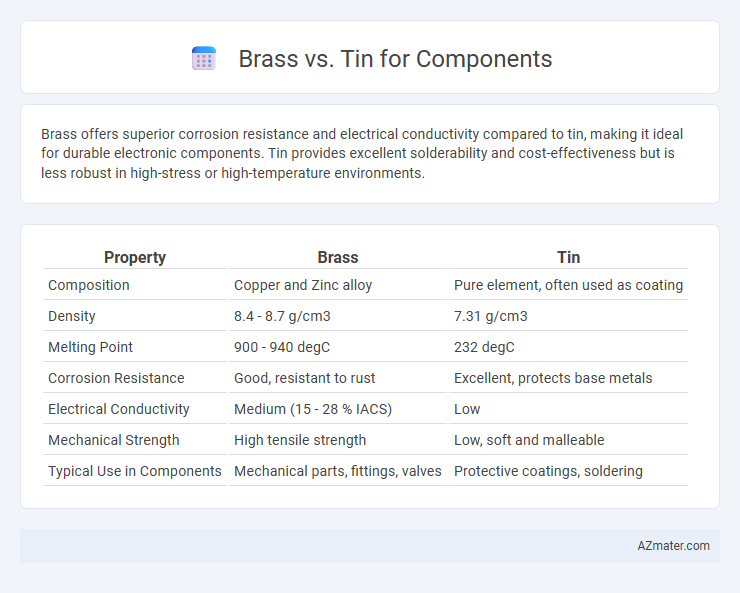Brass offers superior corrosion resistance and electrical conductivity compared to tin, making it ideal for durable electronic components. Tin provides excellent solderability and cost-effectiveness but is less robust in high-stress or high-temperature environments.
Table of Comparison
| Property | Brass | Tin |
|---|---|---|
| Composition | Copper and Zinc alloy | Pure element, often used as coating |
| Density | 8.4 - 8.7 g/cm3 | 7.31 g/cm3 |
| Melting Point | 900 - 940 degC | 232 degC |
| Corrosion Resistance | Good, resistant to rust | Excellent, protects base metals |
| Electrical Conductivity | Medium (15 - 28 % IACS) | Low |
| Mechanical Strength | High tensile strength | Low, soft and malleable |
| Typical Use in Components | Mechanical parts, fittings, valves | Protective coatings, soldering |
Introduction to Brass and Tin in Component Manufacturing
Brass, an alloy of copper and zinc, offers excellent machinability, corrosion resistance, and electrical conductivity, making it ideal for precision components in electronics and plumbing. Tin, a soft, malleable metal primarily used as a coating material, enhances solderability and corrosion resistance in component manufacturing. Choosing between brass and tin depends on the specific application requirements, balancing strength, conductivity, and protection against environmental factors.
Material Composition and Properties
Brass, an alloy primarily composed of copper and zinc, offers excellent corrosion resistance and high machinability, making it ideal for components requiring durability and strength. Tin, a soft metal often used as a coating or in alloys like bronze, provides superior anti-corrosive properties and resistance to oxidation but lacks the mechanical strength of brass. The choice between brass and tin for components depends largely on the need for structural integrity versus corrosion resistance in specific environmental conditions.
Mechanical Strength: Brass vs Tin
Brass exhibits significantly higher mechanical strength compared to tin, making it a preferred material for components requiring durability and resistance to deformation. The tensile strength of brass ranges from 300 to 600 MPa, while tin typically has a much lower tensile strength around 15 to 30 MPa. This difference ensures brass components better withstand mechanical stresses in industrial and electronic applications.
Corrosion Resistance Comparison
Brass offers superior corrosion resistance in marine and industrial environments due to its copper-zinc alloy composition, which forms a protective oxide layer that inhibits rust formation. Tin, commonly used as a coating rather than a base material, provides excellent resistance to oxidation and corrosion in electrical components by preventing exposure to air and moisture. While brass withstands mechanical wear and galvanic corrosion better, tin plating is preferred for enhancing solderability and protecting sensitive electronic contacts.
Electrical Conductivity Differences
Brass exhibits lower electrical conductivity compared to tin due to its copper-zinc alloy composition, which restricts the free flow of electrons. Tin, being a purer metal with higher electrical conductivity, is often preferred for electrical contacts and soldering applications where efficient current transfer is critical. The difference in conductivity impacts the choice of component materials, with tin favored in high-performance electrical components requiring minimal resistive loss.
Cost and Availability of Brass vs Tin
Brass generally offers lower cost and higher availability compared to tin, making it a more economical choice for large-scale component manufacturing. The abundance of copper and zinc, the primary metals in brass, contributes to its stable pricing and wide market access, whereas tin's limited supply and higher extraction costs often result in elevated prices. Manufacturers prefer brass for cost-sensitive applications without compromising on material performance and supply chain reliability.
Applications in Electronics and Engineering
Brass offers excellent electrical conductivity and corrosion resistance, making it ideal for connectors, terminals, and switches in electronic devices, while tin provides superior solderability essential for circuit board assembly and component joining. Engineering applications favor brass for mechanical parts such as gears and valves due to its strength and machinability, whereas tin's low melting point and flexibility support protective coatings and plating on electronic components to prevent oxidation. The combination of brass for structural integrity and tin for joining processes enhances reliability and performance in advanced electronic and engineering systems.
Environmental Impact and Sustainability
Brass, an alloy of copper and zinc, offers high recyclability, reducing environmental impact due to its ability to be melted and reused without significant degradation. Tin, commonly used as a coating in electronics, is less energy-intensive to produce but faces challenges with mining-related environmental degradation and supply constraints. Choosing brass over tin may enhance sustainability through better material lifespan and recycling efficiency, while tin's environmental footprint depends heavily on responsible sourcing practices.
Machinability and Workability Factors
Brass exhibits superior machinability compared to tin due to its excellent chip formation and resistance to tool wear, making it ideal for precision components requiring tight tolerances. Tin, while softer and easier to work with in forming and bending processes, lacks the strength and durability needed for machining-intensive applications, often resulting in faster tool degradation. The choice between brass and tin components hinges on balancing the ease of machining with the necessity for workability in the final product's operational environment.
Choosing Between Brass and Tin for Components
Brass offers superior strength, corrosion resistance, and durability, making it ideal for mechanical components requiring high wear resistance and structural integrity. Tin, known for its excellent corrosion resistance and solderability, is commonly used as a coating to protect base metals and enhance electrical conductivity in electronic components. Selecting between brass and tin depends on the application's mechanical demands and environmental exposure, with brass favored for robust parts and tin preferred for protective coatings and electronic contacts.

Infographic: Brass vs Tin for Component
 azmater.com
azmater.com